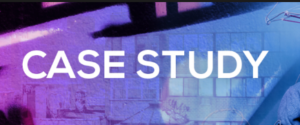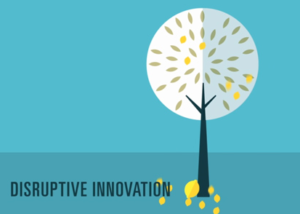Disruptive innovation and change have become the norm. Most of us know that if we don’t proactively innovate and change the game, someone else will rewrite the rules for us. Just think Blockbuster, Borders, Blackberry, and Kodak. Today lets study a disruptive innovation case study.

At the same time, business culture reinforces the idea that uncertainty should be avoided at all costs. Control is the goal.
No wonder every management book on Amazon that uses the word “surprise” in its title focuses on preventing the phenomenon from occurring.
But here’s the problem. Disruptive innovation and change aren’t formulaic. Whether we’re intentionally innovating or responding to competitive threats, today’s leaders (and most employees) must live with constant uncertainty and continually respond to the unpredictable.
When we think about entrepreneur leaders, we usually think about young technologists in co-working spaces coming up with the next big smartphone app. Yet some of the smartest innovators aren’t working with code or looking for a lucrative exit. They are working to find sustainable solutions to some of the world’s toughest problems.
Our inherently uncertain environment demands a new set of competencies focused on navigating disruptive change while proactively driving game-changing breakthroughs. Five leadership competencies are essential for success in today’s unpredictable world.
And these competencies need to be embraced by leaders, role modeled, and instilled into teams and individuals across the organization.
Disruptive Innovation Case Study … A Leapfrogging Mindset
Leading disruptive innovation and change involves leapfrogging—creating or doing something radically new or different that produces a significant leap forward.
People who possess an unyielding desire to create a breakthrough ensure that everything they do focuses on adding a whole new level of value to customers, the market, and the organization.

Boundary Pushing
Pushing boundaries is important on two levels. On the personal side, people who live abroad, work across multiple functions and surround themselves with diverse team members continually broaden their mindsets and enhance creative problem-solving skills.
From a strategic perspective, they push the limits of their colleagues, teams, organizations, and partners.
Data-intuition integration
Most leaders demand hard data when making critical decisions. In times of disruptive change, robust data rarely exist. Leaders must use any information they can obtain from any source inside and outside the company—but then complement that data by using their gut to round out the equation.
Disruptive Innovation Case Study… adaptive planning
Leading disruptive innovation requires managing unsurpassed levels of uncertainty. Adaptive planning involves taking action to drive results, learning from them, and then modifying assumptions and approaches accordingly.
Whether these “results” are good or bad, they bring us closer to our breakthroughs since they result in new insights—just like Gatorade experienced. These new insights shape our future strategies, plans, and actions, which are better aligned to the needs of the market.
Savoring surprise
Disruptive innovation and change is a process chock full of surprise—failures, successes, unexpected technological advancements, competitive moves, customer feedback, political and regulatory shifts, and other unforeseen events.
Most leaders assume surprises always should be avoided. But those who realize that surprises are an inevitable part of the business (just like life) are best equipped to use surprise as a strategic tool—which makes them the agilest and fastest to respond to or capitalize on unforeseen events.
In today’s turbulent environment, disruptive innovation and transformational change go hand in hand. Companies that want to proactively drive game-changing breakthroughs must give their leaders and employees the requisite mindsets, skills, and tools to break through—personally and on behalf of the business.

There is a lot of misinterpretation about what ‘being focused’ actually means:
The focus is not about accomplishing your tasks; it is about accomplishing your vision!
A few years ago I was asked by a CEO to facilitate his executive team meeting. He explained to me what he believed was the main challenge for his organization:
“We have been very successful in the past decades as a company especially because we knew our strong points. Our whole way of working was aimed at maximizing our strong points without letting ourselves be distracted by other stuff. By doing this, we created two kinds of people: the ‘managers’ who managed our products; and the ‘sales entrepreneurs’ who managed our customers”.
Now we are faced with a changing market, and we are not capable of responding quickly enough to these changes. Our managers and sales entrepreneurs are both screaming for more focus from the top. But they mean: ‘do not disturb us with your change initiatives and let us focus on what we’re good at making our products and selling these to our customers.’
They do not see that this kind of focus is no longer helping us forward at all. In fact, we need to change our focus, instead of sticking to what we always did.
And for this, we do need not only management and entrepreneurship but also leadership. Not only in the top, but on all levels of the organization.
Leaders who can create a shared focus on a new way forward; who can align their people around this new focus; who are people, team, collaboration-oriented, as much as the product, efficiency, customer oriented.”
The story of this CEO shows his interpretation of the required focus: the pressure to change and adapt demands a new focus.
It demands a new focus based on looking forward, on knowing what we want to create together, on why this is important, and on the benefits we see. Focusing on the things we want to change, to create the company we want to become.
And yet, quite often when confronted with the need for change we see leaders proclaiming a focus, which is far removed from the focus described above. They describe a focus that is task oriented, short-term oriented, focused on strengthening what we do today.
In some business situations creating a focus aimed at ‘keeping and strengthening what we have got’ can be justified. However, most situations require leaders who create a different focus, one that aims at creating successful and sustainable change.
Not easy! Most people seem to be able to live with a company focus that is keeping them inside the known territory. If for instance, we need to do more of the same in less time, raise the quality level of our product or service, or produce at lower cost; we seem to be able to deal with this.
People will maybe not like the pressure that this company focus is putting on them, but they will go along with it. Up to the level that all energy and ideas are used, and nothing is left. At that moment people reach the limit of what they believe is possible, feel numb and start acting unmotivated and uninspired.
At that moment the company probably realizes that it needs to change more fundamentally and that it will take substantial energy to do that. The energy that most people don’t have any more at that moment!
Successful leaders create organizations that focus differently. In their organizations, the focus is always aimed at the future, at how we see our desired future, at what we need to do differently to get there, at what we collectively gain when reaching it.
At first, they will encounter resistance and hesitation within the organization. Not so strange, because people are asked to get outside their comfort zones. The desired future is new, and there is maybe uncertainty and a lack of confidence, so people will not easily follow.
Nevertheless, successful leaders succeed in aligning their people around this focus. I observe the following recurring traits:
Leadership Qualities: The Go-Getter’s Guide to Lifelong Learning
Disruptive Innovation Case Study … they are persistent in their focus
They stick to the focus, even if results are not forthcoming at first sight. They show confidence and stay focused. This does not mean they will never change course, and will always rigidly keep following the initial plan.
When they see that the vision will not be reached by maintaining the current focus, they are the first to shift focus. But as long as the focus is directing us towards the vision, they will keep this focus.
Their focus is aimed at the longer term
They have a longer-term focus based on their vision of their company’s desired future. They link the company focus to this desired future. They share their vision actively and discuss it openly with the organization.
They do not lose energy in focusing on short-term temporary improvements; they focus on creating sustainable results.
Disruptive Innovation Case Study … the focus reveals personal alignment
They know their qualities and weak points very well, as well as what they stand for. They act based on clear personal values and include these in their vision. Because of their high level of personal alignment, they explore different opinions with an open mind and feel no need to focus on themselves.
Their focus is always on creating the best company results, in line with these key values.
The focus arouses an eagerness
They pay special attention to the process of building a shared focus throughout the organization. The focus is not just setting out tasks and actions. It is about creating shared energy that drives us towards a common result.
They invite people to take part in defining the focus that is needed to create the desired future, and this builds motivation and commitment.
The focus is on releasing smart energy
They are only interested in decisions and actions that will bring us closer to our destination. Even more, they are continuously challenging people to focus on the levers for change that will boost us forward, and not focus on trivial things.
They are allergic to ‘jumping to conclusions’ without knowing how it will bring us closer to our goal. But they are also allergic to procrastination and risk aversion when the way forward is to ‘experiment – learn – adjust.’
“The hardest thing when you think about focusing. You think focusing is about saying ‘Yes.’ No. Focusing is about saying ‘No.’” – Steve Jobs
Today we need to manage not for stability, but for disruption. So instead of just planning against established metrics, we also need to continually ask what we’re doing to explore the unknown.
Not all who wander are lost.

Need some help in improving the innovation process for you and your staff? Innovative ideas to help the differentiation with your toughest competitors? Or maybe ways to innovate new products and services?
Call today for a FREE consultation or a FREE quote. Learn about some options for innovation workshops to get noticeable results.
Call Mike at 607-725-8240.
All you get is what you bring to the fight. And that struggle gets better every day you learn and apply new innovative ideas.
When things are not what you want them to be, what’s most important is your next step. Call today.
Test. Learn. Improve. Repeat.
Do you have a lesson about making your innovation learning better you can share with this community? Have any questions or comments to add in the section below?
Digital Spark Marketing will stretch your thinking and your ability to adapt to change. We also provide some fun and inspiration along the way. Call us for a free quote today. You will be amazed at how reasonable we will be.
More reading on creativity and innovation from Digital Spark Marketing’s Library:
Learn How to Think What No One Else Thinks
Generating Ideas by Convergent Thinking
Amazon and Managing Innovation … the Jeff Bezos Vision
The Secrets to Building an Innovative Culture
Mike Schoultz is a digital marketing and customer service expert. With 48 years of business experience, he consults on and writes about topics to help improve the performance of a small business. Find him on G+, Facebook, Twitter, Digital Spark Marketing, and LinkedIn.